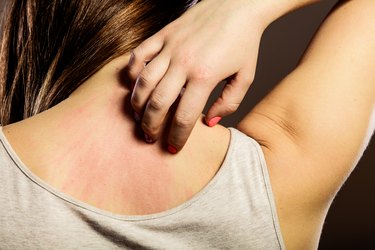
Spot a skin rash you think could be related to your vitamin D intake? Vitamin D is in a host of foods and products that could potentially — though rarely — flare up a rash response. But before you make any rash decisions and cut vitamin D, here's the science behind why this may happen.
Too Much of a Good Thing
Video of the Day
It's possible to get sick from getting too much vitamin D, according to the Mayo Clinic. This is usually a result of supplement dosage, as opposed to your dietary intake or sun exposure.
Video of the Day
This is known as hypervitaminosis D, per the Mayo Clinic, and the symptoms include:
- Weakness
- Frequent urination
- Nausea and vomiting
Over time, the condition can contribute to bone pain and kidney problems, such as kidney stones.
Your skin may also be affected by your vitamin D levels — but not just from getting too much.
A February 2018 study in Skin Pharmacology and Physiology found that vitamin D deficiency was associated with a risk of developing atopic dermatitis, a skin condition characterized by dry, itchy skin.
"Those with either low vitamin D levels or high vitamin D levels may be susceptible to skin rash or skin irritations, although this is not a common occurrence," says Villanova, Pennsylvania-based Lisa Diewald, RD, LDN, a registered dietitian nutritionist, and program manager of the MacDonald Center for Obesity Prevention and Education (COPE) at Villanova University. "Like any medication or supplement, it is possible to experience an allergic reaction to vitamin D that could cause a mild allergic reaction such as a skin rash or hives."
Diewald says that, as with the other symptoms above, skin rash would most likely result from taking too many vitamin D supplements.
"Sunlight provides some of the vitamin D that we need, and the absorption of vitamin D from the sun will slow down as we meet our needs, so there is a built-in mechanism for preventing excess vitamin D from sunlight," she says. But that's not the case with supplements. "Consumers should be mindful that more is not always better when it comes to supplements."
Soothing the Rash
If skin irritation or rash occurs due to vitamin D use, Diewald says that it typically resolves after you stop taking it.
"Stop taking the supplement, and observe for improvement," she says. "If no improvement occurs or symptoms worsen, contact your physician for guidance."
In the meantime, over-the-counter hydrocortisone creams or oral antihistamines such as loratadine (Claritin) can help relieve any itchiness related to most rashes, according to Michigan Medicine.
Getting Your Daily Vitamin D
According to the Mayo Clinic, you want to aim for 600 IUs of vitamin D daily (800 IUs if you're over 70).
Vitamin D intake can aid in cognitive health and is linked to lower rates of myriad diseases, Mayo Clinic says, including:
- Cancer
- Inherited disorders (hypophosphatemia)
- Osteomalacia
- Osteoporosis
- Psoriasis
- Rickets
The Cleveland Clinic adds to that list the following conditions:
- Heart disease
- High blood pressure
- Diabetes
- Infections and immune system disorders
- Multiple sclerosis
But getting adequate vitamin D can prove tricky.
"Dietary sources of vitamin D are limited, and include fortified milk, non-dairy milks and breakfast cereals, along with foods such as salmon and fish oil," Diewald says.
We get a lot of our vitamin D from sun exposure, according to the Mayo Clinic, although, beyond food, it's popular in supplements as well.
Diewald says that reducing your risk of skin rash and other issues from vitamin D intake is fairly straightforward.
"Since adverse effects from excess vitamin D are likely to come from supplements and not dietary sources, try to optimize your dietary intake first, and be sure to spend some time in the sun to gain some additional vitamin D," Diewald says.
"If you choose to take supplements, the tolerable upper limit — the maximum daily amount that is considered to be safe for most people — is 4,000 IU," she says.
"Too much can be toxic and increase your risk for reactions, so if you do take vitamin D supplements, read the label and avoid taking more than 1,000 IU daily without guidance from your physician, who may want to check your vitamin D levels to be sure they remain in a healthy range," Diewald says.
- Mayo Clinic: “Vitamin D”
- Lisa Diewald, MS, RD, LDN, program manager, MacDonald Center for Obesity Prevention and Education, M. Louise Fitzpatrick College of Nursing, Villanova University, Villanova, Pennsylvania
- Cleveland Clinic: “Vitamin D Deficiency”
- Mayo Clinic: “What Is Vitamin D Toxicity? Should I Be Worried About Taking Supplements?”
- Michigan Medicine: “Skin Rashes: Home Treatment”
- Skin Pharmacology and Physiology: “Vitamin D and the Pathophysiology of Inflammatory Skin Diseases”
Is this an emergency? If you are experiencing serious medical symptoms, please see the National Library of Medicine’s list of signs you need emergency medical attention or call 911.